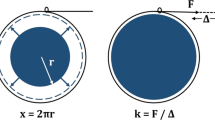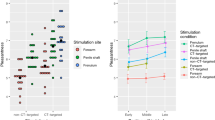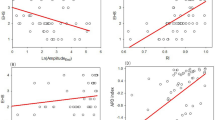Abstract
To assess cavernous nerve integrity, we measured evoked cavernous activity (ECA) in 16 men who underwent nerve sparing radical prostatectomy (NS group) and 11 men who underwent non-nerve-sparing surgery (non-NS group). The right median nerve was electrically stimulated and ECA was recorded with two concentric electromyography needles placed into the right and left cavernous bodies. We simultaneously recorded hand and foot sympathetic skin responses (SSRs) as controls. All subjects had recordable SSR, and all subjects following nerve-sparing radical prostatectomy had reproducible ECA. Of the 11 non-NS subjects, eight had no response, indicating interrupted corporal innervation. Three subjects had reproducible ECA, one of whom had a very late latency, suggesting residual innervation was present. The mean latencies of ECA were similar to foot SSR mean latencies (P>0.05), but not to hand SSR latencies. The non-NS group was significantly different from the NS group for the presence of ECA (P<0.001). ECA is a viable method of evaluating the autonomic innervation of the penis.
This is a preview of subscription content, access via your institution
Access options
Subscribe to this journal
Receive 8 print issues and online access
$259.00 per year
only $32.38 per issue
Buy this article
- Purchase on Springer Link
- Instant access to full article PDF
Prices may be subject to local taxes which are calculated during checkout



Similar content being viewed by others
References
Yilmaz U, Soylu A, Ozcan C, Kutlu R, Gunes A . Evoked cavernous activity. J Urol 2002; 167: 188–191.
Yarnitsky D, Sprecher E, Barilan Y, Vardi Y . Corpus cavernosum electromyogram: spontaneous and evoked electrical activities. J Urol 1995; 153: 653–654.
Claus D, Schondorf R . Sympathetic skin response. The International Federation of Clinical Neurophysiology. Electroencephalogr Clin Neurophysiol Suppl 1999; 52: 277–282.
Shahani BT, Halperin JJ, Boulu P, Cohen J . Sympathetic skin response – a method of assessing unmyelinated axon dysfunction in peripheral neuropathies. J Neurol Neurosurg Psychiatry 1984; 47: 536–542.
Giuliano F, Rampin O, Jardin A, Rousseau JP . Electrophysiological study of relations between the dorsal nerve of the penis and the lumbar sympathetic chain in the rat. J Urol 1993; 150: 1960–1964.
Paick JS, Donatucci CF, Lue TF . Anatomy of cavernous nerves distal to prostate: microdissection study in adult male cadavers. Urology 1993; 42: 145–149.
Yucel S, Baskin LS . Identification of communicating branches among the dorsal, perineal and cavernous nerves of the penis. J Urol 2003; 170: 153–158.
Takenaka A, Murakami G, Matsubara A, Han SH, Fujisawa M . Variation in course of cavernous nerve with special reference to details of topographic relationships near prostatic apex: histologic study using male cadavers. Urology 2005; 65: 136–142.
Zippe CD, Kedia AW, Kedia K, Nelson DR, Agarwal A . Treatment of erectile dysfunction after radical prostatectomy with sildenafil citrate (Viagra). Urology 1998; 52: 963–966.
Moreno AP, Campos de Carvalho AC, Christ G, Melman A, Spray DC . Gap junctions between human corpus cavernosum smooth muscle cells: gating properties and unitary conductance. Am J Physiol 1993; 264: C80–C92.
Vetrugno R, Liguori R, Cortelli P, Montagna P . Sympathetic skin response: basic mechanisms and clinical applications. Clin Auton Res 2003; 13: 256–270.
Kern RZ . The electrodiagnosis of ulnar nerve entrapment at the elbow. Can J Neurol Sci 2003; 30: 314–319.
Carter GT, Robinson LR, Chang VH, Kraft GH . Electrodiagnostic evaluation of traumatic nerve injuries. Hand Clin 2000; 16: 1–12, vii.
Curt A, Dietz V . Electrophysiological recordings in patients with spinal cord injury: significance for predicting outcome. Spinal Cord 1999; 37: 157–165.
Haldeman S, Bradley WE, Bhatia NN, Johnson BK . Pudendal evoked responses. Arch Neurol 1982; 39: 280–283.
Vodusek DB . Evoked potential testing. Urol Clin N Am 1996; 23: 427–446.
Yang CC, Bradley WE . Somatic innervation of the human bulbocavernosus muscle. Clin Neurophysiol 1999; 110: 412–418.
Sasso F, Gulino G, Alcini A, Alcini E . Early experience of corpora cavernosa electromyography in impotent patients after radical cystoprostatectomy. Eur Urol 1996; 29: 466–469.
Sasso F, Gulino G, Alcini E . Corpus cavernosum electromyography (CC-EMG): a new technique in the diagnostic work-up of impotence. Int Urol Nephrol 1996; 28: 805–818.
Kayigil O, Ergen A . Caverno-occlusive and autonomic dysfunction: a new concept in young patients. Eur Urol 1998; 34: 124–127.
Jiang XG, Speel TG, Wagner G, Meuleman EJ, Wijkstra H . The value of corpus cavernosum electromyography in erectile dysfunction: current status and future prospect. Eur Urol 2003; 43: 211–218.
Sasso F, Stief CG, Gulino G, Alcini E, Junemann KP, Gerstenberg T et al. Progress in corpus cavernosum electromyography (CC-EMG) – third international workshop on corpus cavernosum electromyography (CC-EMG). Int J Impot Res 1997; 9: 43–45.
Stief CG, Junemann KP, Kellner B, Gerstenberg T, Merckx L, Wagner G . Consensus and progress in corpus cavernosum-EMG (CC-EMG). Int J Impot Res 1994; 6: 177–182.
Author information
Authors and Affiliations
Corresponding author
Rights and permissions
About this article
Cite this article
Yilmaz, U., Ellis, W., Lange, P. et al. Evoked cavernous activity: measuring penile autonomic innervation following pelvic surgery. Int J Impot Res 18, 296–301 (2006). https://doi.org/10.1038/sj.ijir.3901407
Received:
Revised:
Accepted:
Published:
Issue Date:
DOI: https://doi.org/10.1038/sj.ijir.3901407
Keywords
This article is cited by
-
Evoked cavernous activity: neuroanatomic implications
International Journal of Impotence Research (2009)



